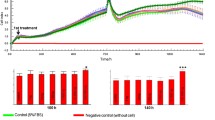Abstract
The present study describes the dynamic process of both acellular extrinsic (AEFC) and acellular/cellular intrinsic fiber cementum (AIFC/CIFC) matrix production on growing human teeth. Selected erupting maxillary and mandibular premolars with roots grown to about 70%–95% of their final length were placed in organ culture immediately following extraction. Twelve teeth for short-time labeling were pulse-incubated for 15 min in medium containing 3H-proline and chased for various times in order to follow the migration and secretion of the tracer. Eight teeth for long-time incubation were labeled continuously for 5 h before being chased for 1–8 days in order to label cementum matrix accumulation. After decalcification in ethylene diaminetetraacetic acid (EDTA), their roots were subdivided into about 20 slices each. Epon-embedded sections were prepared for light- and electron-microsopic as well as autoradiographic examination. During CIFC-formation, cementoblasts revealed high intracytoplasmic silver grain concentrations within the first hour after 3H-proline administration. The release of the tracer occurred between 60 to 120 min after administration. After 2 h, cementoblasts and the cementum matrix appeared to be labeled about equally. After 5 h, most of the labeled proteins appeared to be localized in the cementoid. Silver grains increased in number over the cementum matrix from 5–24 h. Very high intracellular grain concentrations within very large cementoblasts corresponded to regions of rapid cementum formation. Tracer-halos around entrapped cells lend support to a multipolar mode of matrix production during CIFC-initiation. The fate of the tracer during the development of early AEFC-matrix was less clear. However, fibroblasts revealed dense intracytoplasmic grain accumulations within the first hour after 3H-proline administration. Thereafter, the tracer localization was vague. This indistinct grain localization reflected the particular mode of AEFC-matrix production characterized by addition of new fibril segments to pre-existing fibers of a collagenous fringe.
Similar content being viewed by others
References
Bosshardt DD (1992) Morphologische, morphodynamische und autoradiographische Untersuchung der Zementogenese an menschlichen Zähnen. Thesis, Swiss Federal Institute of Technology, Zurich
Bosshardt DD, Schroeder HE (1990) Evidence for rapid multipolar and slow unipolar production of human cellular and acellular cementum matrix with intrinsic fibers. J Clin Periodontol 17:663–668
Bosshardt DD, Schroeder HE (1991a) Initiation of acellular extrinsic fiber cementum on human teeth. A light- and electron-microscopic study. Cell Tissue Res 263:311–324
Bosshardt DD, Schroeder HE (1991b) Establishment of acellular extrinsic fiber cementum on human teeth. A light- and electron-microscopic study. Cell Tissue Res 263:325–336
Bosshardt DD, Schroeder HE (1992) Initial formation of cellular intrinsic fiber cementum in developing human teeth. A light-and electron-microscopic study. Cell Tissue Res 267:321–335
Bosshardt DD, Luder HU, Schroeder HE (1989) Rate and growth pattern of cementum apposition as compared to dentine and root formation in a fluorochrome-labelled monkey (Macaca fascicularis). J Biol Buccale 17:3–13
Bowes JH, Kenten RH (1948) The amino acid composition and titration curve of collagen. Biochem J 43:358–365
Christner P, Robinson P, Clark CC (1977) A preliminary characterization of human cementum collagen. Calcif Tissue Res 23:147–150
Formicola AJ, Krampf JI, Witte ET (1971) Cementogenesis in developing rat molars. J Periodontol 42:766–773
Frank RM, Frank P (1969) Autoradiographie quantitative de l'ostéogenèse en microscopie életronique à l'aide de la proline tritiée. Z Zellforsch 99:121–133
Frasca JM, Parks VR (1965) A routine technique for double-staining ultrathin sections using uranyl and lead salts. J Cell Biol 25:157–161
Karnovsky MJ (1965) A formaldehyde-glutaraldehyde fixative of high osmolarity for use in electron microscopy. J Cell Biol 27:137A-138A
Krum JM, Rosenstein JM, Silverman WF (1991) An alternate method for staining plastic embedded autoradiographs. J Histotechnol 14:43–45
Levine P, Glimcher MJ, Bonar LC (1964) Collagenous layer covering the crown enamel of unerupted permanent human teeth. Science 146:1676–1678
Marks SC, Popoff SN (1988) Bone cell biology: the regulation of development, structure and function in the skeleton. Am J Anat 183: 1–44
Morris NP, Fessler LI, Weinstock A, Fessler JH (1975) Procollagen assembly and secretion in embryonic chick bone. J Biol Chem 250:5719–5726
Nefussi JR, Sautier JM, Nicolas V, Forest N (1991) How osteoblasts become osteocytes: a decreasing matrix forming process. J Biol Buccale 19:75–82
Preisig E, Schroeder HE (1988) Long-term culture of human periodontal ligament cells with autologous root discs. J Periodont Res 23:211–221
Reynolds ES (1963) The use of lead citrate at high pH as an electron-opaque stain in electron microscopy. J Cell Biol 17:208–212
Rodriguez MS, Wilderman MN (1970) Amino acid composition of periodontal tissues. J Periodontol 41:591–596
Rodriguez MS, Wilderman MN (1972) Amino acid composition of the cementum matrix from human molar teeth. J Periodontol 43:438–440
Rohr H (1965) Die Kollagensynthese in ihrer Beziehung zur submikroskopischen Struktur des Osteoblasten. Elektronenmikroskopisch-autoradiographische Untersuchung mit Tritium-markiertem Prolin. Virchows Arch [A] 338:342–354
Schroeder HE (1986) The Periodontium. In: Oksche A, Vollrath L (eds) Handbook of microscopic anatomy, vol V/5. Springer, Berlin Heidelberg New York, pp 121–128, 313–319
Schroeder HE (1992) Biological problems of regenerative cementogenesis: synthesis and attachment of collagenous matrices on growing and established root surfaces. Int Rev Cytol 142:1–59
Schroeder HE, Rossinsky K, Müller W (1980) An established routine method for differential staining of epoxy-embedded tissue sections. Microsc Acta 83:111–116
Sequeira P, Bosshardt DD, Schroeder HE (1992) Growth of acellular extrinsic fiber cementum (AEFC) and density of inserting fibers in human premolars of adolescents. J Periodont Res 27:134–142
Trelstad RL, Hayashi K (1979) Tendon collagen fibrillogenesis: intracellular subassemblies and cell surface changes associated with fibril growth. Dev Biol 71:228–242
Weinstock A, Bibb C, Burgeson RE, Fessler LI, Fessler JH (1975) Intracellular transport and secretion of pro-collagen in chick bone as shown by E.M. radioautography and biochemical analysis. In: Slavkin HC, Greulich RC (eds) Extracellular Matrix Influences on Gene Expression. Academic Press, New York, pp 321–330
Author information
Authors and Affiliations
Rights and permissions
About this article
Cite this article
Bosshardt, D.D., Schroeder, H.E. Attempts to label matrix synthesis of human root cementum in vitro. Cell Tissue Res 274, 343–352 (1993). https://doi.org/10.1007/BF00318753
Received:
Accepted:
Issue Date:
DOI: https://doi.org/10.1007/BF00318753




